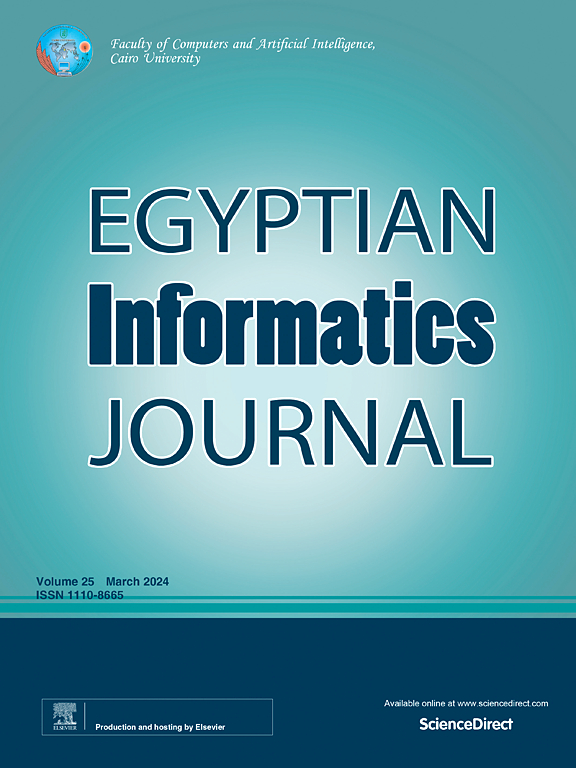Heart disease prediction using autoencoder and DenseNet architecture
IF 5
3区 计算机科学
Q1 COMPUTER SCIENCE, ARTIFICIAL INTELLIGENCE
引用次数: 0
Abstract
Heart disease continues to be a prominent cause of death globally, emphasizing the critical requirement for precise prediction techniques and prompt therapies. This research presents a new method that utilizes the collective capabilities of autoencoder and DenseNet architectures to predict heart illness. Our study is based on the Heart Disease UCI Cleveland dataset, which includes 13 variables that cover clinical and demographic parameters such as age, sex, cholesterol levels, and exercise-induced angina. The dataset presents issues due to its varied attribute types, including category and numerical variables. Furthermore, our approach tackles these difficulties by utilizing a dense autoencoder model, which produced exceptional outcomes. The Model attained a mean accuracy of 99.67% on the Heart Disease UCI Cleveland dataset. Further testing showed it was resilient, with a test accuracy of 99.99%. In addition, the Model demonstrated outstanding macro precision, macro recall, and macro F1 score, with percentages of 99.98%, 99.97%, and 99.96%, respectively. In addition, our results indicate that combining autoencoder and DenseNet designs shows potential for predicting cardiac disease, with substantial enhancements in accuracy and performance metrics compared to current approaches. This methodology can improve clinical decision-making and patient outcomes in cardiovascular care by accurately finding and defining complex patterns within the data. Notwithstanding these encouraging outcomes, our investigation has constraints. The specific attributes of the dataset utilized may limit the applicability of our findings. Subsequent studies could examine the suitability of our method for various datasets and analyze supplementary variables that may improve forecast precision. Furthermore, it is necessary to conduct prospective validation studies to evaluate our strategy’s practical effectiveness in clinical environments.
利用自动编码器和 DenseNet 架构预测心脏病
心脏病仍然是全球死亡的一个主要原因,这就强调了对精确预测技术和及时治疗的迫切需求。本研究提出了一种新方法,利用自动编码器和 DenseNet 架构的集体能力来预测心脏病。我们的研究基于心脏病 UCI 克利夫兰数据集,该数据集包含 13 个变量,涵盖临床和人口统计参数,如年龄、性别、胆固醇水平和运动诱发的心绞痛。由于该数据集的属性类型多种多样,包括类别变量和数字变量,因此存在一些问题。此外,我们的方法利用密集的自动编码器模型解决了这些难题,并取得了卓越的成果。该模型在心脏病 UCI 克利夫兰数据集上的平均准确率达到 99.67%。进一步测试表明,该模型具有很强的适应能力,测试准确率达到 99.99%。此外,该模型的宏观精确度、宏观召回率和宏观 F1 分数也表现出色,分别达到 99.98%、99.97% 和 99.96%。此外,我们的研究结果表明,结合自动编码器和 DenseNet 设计具有预测心脏疾病的潜力,与目前的方法相比,准确率和性能指标都有大幅提高。这种方法能准确发现和定义数据中的复杂模式,从而改善心血管护理的临床决策和患者预后。尽管取得了这些令人鼓舞的成果,但我们的研究也有局限性。所使用数据集的特定属性可能会限制我们研究结果的适用性。后续研究可以检查我们的方法是否适用于各种数据集,并分析可能提高预测精度的补充变量。此外,有必要进行前瞻性验证研究,以评估我们的策略在临床环境中的实际效果。
本文章由计算机程序翻译,如有差异,请以英文原文为准。
求助全文
约1分钟内获得全文
求助全文
来源期刊

Egyptian Informatics Journal
Decision Sciences-Management Science and Operations Research
CiteScore
11.10
自引率
1.90%
发文量
59
审稿时长
110 days
期刊介绍:
The Egyptian Informatics Journal is published by the Faculty of Computers and Artificial Intelligence, Cairo University. This Journal provides a forum for the state-of-the-art research and development in the fields of computing, including computer sciences, information technologies, information systems, operations research and decision support. Innovative and not-previously-published work in subjects covered by the Journal is encouraged to be submitted, whether from academic, research or commercial sources.
 求助内容:
求助内容: 应助结果提醒方式:
应助结果提醒方式:


